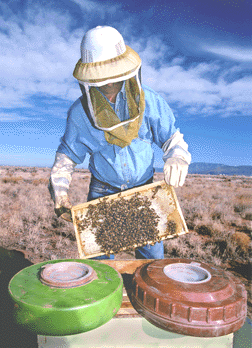steve1958
Drone Bee
- Joined
- Jul 13, 2009
- Messages
- 1,043
- Reaction score
- 260
- Location
- Hampshire UK
- Hive Type
- National
- Number of Hives
- 5
Scientists Are Using Bees to Help Locate and Disarm Land Mines
that are Killing People and Rendering Farm Land Useless

MINE BEES -- A beekeeeper holds honeybees that are helping researchers at
Sandia National Laboratories and the University of Montana determine whether
foraging bees can detect buried landmines.
In the foreground are two unfused antitank mines.
Bromenshenk and his colleagues have shown that as bees forage for nectar and pollen,
they attract particles of dust, soil, and pollen to their fuzzy, statically charged bodies
and bring samples back to the hive. In doing so they provide a chemical survey of
an area extending a mile or more from the hive in all directions.
"Bees are like flying dust mops," says Bromenshenk.
"Wherever they go, they pick up dust, airborne chemicals, and other samples.
If it's out there, they'll find it and bring it back."
No wonder the little 'Dust mops' end up with various diseases.
They must 'Mop up' some really horrible environmental rubbish.
Bromenshenk has demonstrated that by providing a new bee colony with feeders tainted
with a marker chemical, then gradually moving the feeders farther from the hive and eventually removing them,
bees can be trained to forage wherever they smell the chemical. If bees can be trained to seek TNT,
the Montana team may attach small diodes onto the backs of several hundred TNT-trained bees.
Then, using a handheld radar tracking device, they will chart where those bees go to determine
whether they tend to forage near the locations of known landmines
that are Killing People and Rendering Farm Land Useless

MINE BEES -- A beekeeeper holds honeybees that are helping researchers at
Sandia National Laboratories and the University of Montana determine whether
foraging bees can detect buried landmines.
In the foreground are two unfused antitank mines.
Bromenshenk and his colleagues have shown that as bees forage for nectar and pollen,
they attract particles of dust, soil, and pollen to their fuzzy, statically charged bodies
and bring samples back to the hive. In doing so they provide a chemical survey of
an area extending a mile or more from the hive in all directions.
"Bees are like flying dust mops," says Bromenshenk.
"Wherever they go, they pick up dust, airborne chemicals, and other samples.
If it's out there, they'll find it and bring it back."
No wonder the little 'Dust mops' end up with various diseases.
They must 'Mop up' some really horrible environmental rubbish.
Bromenshenk has demonstrated that by providing a new bee colony with feeders tainted
with a marker chemical, then gradually moving the feeders farther from the hive and eventually removing them,
bees can be trained to forage wherever they smell the chemical. If bees can be trained to seek TNT,
the Montana team may attach small diodes onto the backs of several hundred TNT-trained bees.
Then, using a handheld radar tracking device, they will chart where those bees go to determine
whether they tend to forage near the locations of known landmines




